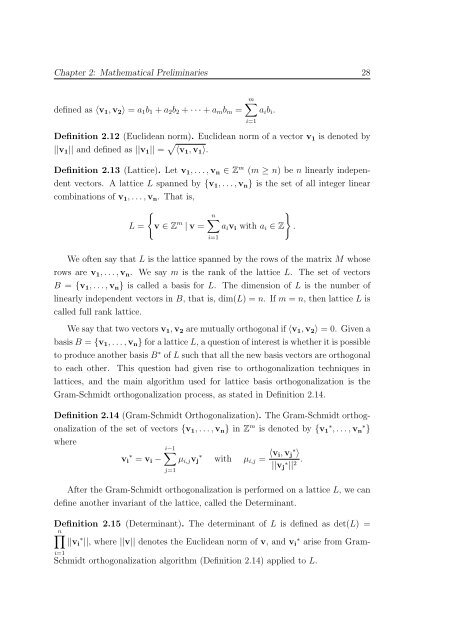Cryptanalysis of RSA Factorization - Library(ISI Kolkata) - Indian ...
Cryptanalysis of RSA Factorization - Library(ISI Kolkata) - Indian ...
Cryptanalysis of RSA Factorization - Library(ISI Kolkata) - Indian ...
You also want an ePaper? Increase the reach of your titles
YUMPU automatically turns print PDFs into web optimized ePapers that Google loves.
Chapter 2: Mathematical Preliminaries 28<br />
defined as 〈v 1 ,v 2 〉 = a 1 b 1 +a 2 b 2 +···+a m b m =<br />
m∑<br />
a i b i .<br />
Definition 2.12 (Euclidean norm). Euclidean norm <strong>of</strong> a vector v 1 is denoted by<br />
||v 1 || and defined as ||v 1 || = √ 〈v 1 ,v 1 〉.<br />
Definition 2.13 (Lattice). Let v 1 ,...,v n ∈ Z m (m ≥ n) be n linearly independent<br />
vectors. A lattice L spanned by {v 1 ,...,v n } is the set <strong>of</strong> all integer linear<br />
combinations <strong>of</strong> v 1 ,...,v n . That is,<br />
L =<br />
{<br />
v ∈ Z m |v =<br />
i=1<br />
}<br />
n∑<br />
a i v i with a i ∈ Z .<br />
i=1<br />
We <strong>of</strong>ten say that L is the lattice spanned by the rows <strong>of</strong> the matrix M whose<br />
rows are v 1 ,...,v n . We say m is the rank <strong>of</strong> the lattice L. The set <strong>of</strong> vectors<br />
B = {v 1 ,...,v n } is called a basis for L. The dimension <strong>of</strong> L is the number <strong>of</strong><br />
linearly independent vectors in B, that is, dim(L) = n. If m = n, then lattice L is<br />
called full rank lattice.<br />
We say that two vectors v 1 ,v 2 are mutually orthogonal if 〈v 1 ,v 2 〉 = 0. Given a<br />
basisB = {v 1 ,...,v n }foralatticeL, aquestion<strong>of</strong>interestiswhetheritispossible<br />
to produce another basis B ∗ <strong>of</strong> L such that all the new basis vectors are orthogonal<br />
to each other. This question had given rise to orthogonalization techniques in<br />
lattices, and the main algorithm used for lattice basis orthogonalization is the<br />
Gram-Schmidt orthogonalization process, as stated in Definition 2.14.<br />
Definition 2.14 (Gram-Schmidt Orthogonalization). The Gram-Schmidt orthogonalization<br />
<strong>of</strong> the set <strong>of</strong> vectors {v 1 ,...,v n } in Z m is denoted by {v 1 ∗ ,...,v n ∗ }<br />
where<br />
∑i−1<br />
v ∗ ∗<br />
i = v i − µ i,j v j<br />
j=1<br />
with µ i,j = 〈v i,v j ∗ 〉<br />
||v j∗ || 2 .<br />
After the Gram-Schmidt orthogonalization is performed on a lattice L, we can<br />
define another invariant <strong>of</strong> the lattice, called the Determinant.<br />
Definition 2.15 (Determinant). The determinant <strong>of</strong> L is defined as det(L) =<br />
n∏<br />
||v ∗ i ||, where ||v|| denotes the Euclidean norm <strong>of</strong> v, and v ∗ i arise from Gram-<br />
i=1<br />
Schmidt orthogonalization algorithm (Definition 2.14) applied to L.
















